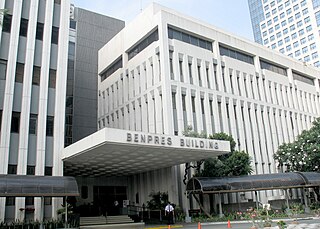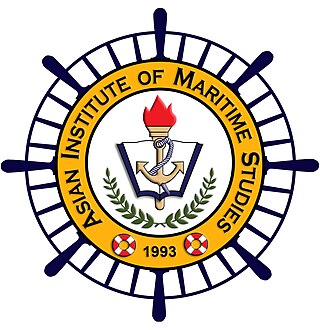
Metropolitan Manila, commonly shortened to Metro Manila and formally the National Capital Region, is the capital region and largest metropolitan area of the Philippines. Located on the eastern shore of Manila Bay, the region lies between the Central Luzon and Calabarzon regions. Encompassing an area of 636.00 km2 (245.56 sq mi) and with a population of 13,484,462 as of 2020, it consists of sixteen highly urbanized cities: the capital city, Manila, Caloocan, Las Piñas, Makati, Malabon, Mandaluyong, Marikina, Muntinlupa, Navotas, Parañaque, Pasay, Pasig, Quezon City, San Juan, Taguig, and Valenzuela, along with one independent municipality, Pateros. As the second most populous and the most densely populated region in the Philippines, it ranks as the 9th most populous metropolitan area in Asia and the 6th most populous urban area in the world.

Manila, officially the City of Manila, is the capital and second-most populous city of the Philippines, after Quezon City. Located on the eastern shore of Manila Bay on the island of Luzon, it is classified as a highly urbanized city. Manila is the world's most densely populated city proper, with 43,611.5 inhabitants per square kilometer (112,953/sq mi) and a population of 1,846,513 people in 2020; it is also the historic core of a built-up area that extends well beyond its administrative limits. Manila was the first chartered city in the country, designated by Philippine Commission Act No. 183 on July 31, 1901. It became autonomous with the passage of Republic Act No. 409, "The Revised Charter of the City of Manila", on June 18, 1949. Manila is considered to be part of the world's original set of global cities because its commercial networks were the first to extend across the Pacific Ocean and connect Asia with the Spanish Americas through the galleon trade. This marked the first time an uninterrupted chain of trade routes circling the planet had been established.

Pasay, officially the City of Pasay, is a highly urbanized city in the National Capital Region of the Philippines. According to the 2020 census, it has a population of 440,656 people.

The Bangko Sentral ng Pilipinas is the central bank of the Philippines. It was established on January 3, 1949, and then re-established on July 3, 1993 pursuant to the provision of Republic Act 7653 or the New Central Bank Act of 1993 as amended by Republic Act 11211 or the New Central Bank Act of 2019. The principal author was Senator Franklin Drilon. It was signed by President Rodrigo Duterte.

Alejandro Reyes Roces was a Filipino author, essayist, dramatist and a National Artist of the Philippines for literature. He served as Secretary of Education from 1962 to 1965, during the term of Philippine President Diosdado Macapagal.

The Government Service Insurance System is a Filipino government-owned and controlled corporation (GOCC) in the Philippines aimed at government employees. Created by Commonwealth Act No. 186 and Republic Act No. 8291, GSIS is a social insurance institution that provides a defined benefit scheme. It insures its members against the occurrence of certain contingencies in exchange for their monthly premium contributions.

The Manila Metropolitan Theater, also known as the Metropolitan Theater, abbreviated as the MET, is a historic Philippine Art Deco building located in Plaza Lawton in Ermita, Manila. It is recognized as the forefront of the Art Deco architectural style in the Philippines.

The López Museum and Library, also known as simply the Lopez Museum, is a Philippine art and history museum and library. It previously was located in Pasig, Philippines at the ground floor of the Benpres Building, Exchange Road corner Meralco Avenue, Ortigas Center.

The Parisian Life, also known as Interior d'un Cafi, is an oil on canvas impressionist painting made by Filipino painter and revolutionary activist Juan Luna in 1892. The painting presently owned by the Government Service Insurance System is currently exhibited at the National Museum of Fine Arts after the state pension fund transferred management of its collection to the National Museum in March 2012.

The Asian Institute of Maritime Studies (AIMS) is a Maritime Higher Education Institution (MHEI) in Pasay, Philippines that provides highly technical learning in maritime education. It is a specialized maritime learning and research institution and considered one of the top performing maritime schools in the Philippines consistently producing top-notchers in board examinations. It was founded in 1993 by Captain Wilijado P. Abuid along with other maritime leaders to provide world-class maritime education to the Filipino youth.

The National Museum of Fine Arts, formerly known as the National Art Gallery, is an art museum in Manila, Philippines. It is located on Padre Burgos Avenue across from the National Museum of Anthropology in the eastern side of Rizal Park. The museum, owned and operated by the National Museum of the Philippines, was founded in 1998 and houses a collection of paintings and sculptures by classical Filipino artists such as Juan Luna, Félix Resurrección Hidalgo and Guillermo Tolentino.

Google Arts & Culture is an online platform of high-resolution images and videos of artworks and cultural artifacts from partner cultural organizations throughout the world, operated by Google.

Jaime del Carmen Laya, better known as Jimmy Laya is a Filipino banker, accountant, and cultural administrator who served as the first Secretary of the Department of Budget and Management of the Republic of the Philippines, serving from 1978 to 1981. He was also the 5th governor of the Central Bank of the Philippines from 1981 to 1984 and later served as the Minister of Education, Culture and Sports from 1984 until 1986. His terms in civil service, covered two significant points in Philippine history, the election that made former President Ferdinand Marcos have his third term and the assassination of the late Senator Benigno S. Aquino Jr. that stimulated the People Power Revolution of 1986.
In the Philippines, a government-owned and controlled corporation (GOCC), sometimes with an "and/or", is a state-owned enterprise that conducts both commercial and non-commercial activity. Examples of the latter would be the Government Service Insurance System (GSIS), a social security system for government employees. There are 219 GOCCs as of 2022. GOCCs both receive subsidies and pay dividends to the national government. A government-owned or controlled corporation is a stock or a non-stock corporation, whether performing governmental or proprietary functions, which is directly chartered by a special law or if organized under the general corporation law is owned or controlled by the government directly, or indirectly through a parent corporation or subsidiary corporation, to the extent of at least a majority of its outstanding capital stock or of its outstanding voting capital stock.
Pinggot Zulueta is a Filipino visual artist and photojournalist.

Winston Fiel Garcia is a Filipino lawyer, and corporate leader who was the general manager and president of Government Service Insurance System. He has served as the director and board member of several of the biggest institutions in the Philippines such as the Philippine Stock Exchange, San Miguel Corporation, Meralco and is currently the chairman of the Garcia-owned Cebu CFI Cooperative.

The Cultural Center of the Philippines Complex, also known as the CCP Complex, is an 88-hectare (220-acre) art district managed by the Cultural Center of the Philippines (CCP) located along Roxas Boulevard in Metro Manila, Philippines. It is a mixed-use cultural and tourism hub overlooking Manila Bay in south-central Manila, most of which fall under the jurisdiction of the city of Pasay.
Wilfredo Beltran Alicdan is a Filipino figurative artist. His works are distinguished by their quaint and geometric folk representations, populated by rounded stylized figures usually engaged in traditional and rural activities.

The GSIS Building is the headquarters of the Government Service Insurance System (GSIS), the corporation that handles social security of the employees of the government of the Philippines. Located in Pasay, it is also the seat of the Senate.

















